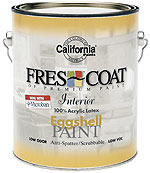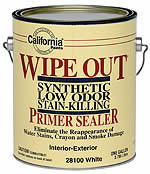
Low-VOC Paints,
Odorless Paint Products
New regulations and virtually odorless application help low-VOC paints secure a growing market segment.
by John Chandler
for contractors and consumers alike that the smell of fresh paint doesn’t have the same cachet as the smell of a new car. Fortunately, we now have odorless paint products, which is good news for the paint professional who needs to come and go quickly on a job where people can’t be displaced for too long.
 Most companies refer to odorless paint as a low- or no-VOC product, the chief difference being in what is left out of the formula as opposed to what’s put in. According to Jim Armstrong, lead chemist for Rodda Paint in Portland, Ore., odorless paints are typically produced without coalescing solvents or solvents used for open time or wet edge. Another odor saver is the elimination of ammonia, which is often used as a buffer. Most companies refer to odorless paint as a low- or no-VOC product, the chief difference being in what is left out of the formula as opposed to what’s put in. According to Jim Armstrong, lead chemist for Rodda Paint in Portland, Ore., odorless paints are typically produced without coalescing solvents or solvents used for open time or wet edge. Another odor saver is the elimination of ammonia, which is often used as a buffer.
Frank Magdits, commercial and industrial projects manager for Benjamin Moore & Co., says that the coalescent agent is a solvent that softens the latex so that it can fuse and form a film. “In low-VOC paint, that solvent isn’t used, but a different type of specialized resin forms the film,” he adds.
 Still, the term “odorless” is debatable, since some say that all paint has an odor if you jam your nose into a freshly opened can. Magdits says that the scent of low-VOC paint is generally “lighter and sweeter and dissipates more quickly than the smell usually associated with wet paint.” Still, the term “odorless” is debatable, since some say that all paint has an odor if you jam your nose into a freshly opened can. Magdits says that the scent of low-VOC paint is generally “lighter and sweeter and dissipates more quickly than the smell usually associated with wet paint.”
And Ron Boyajian of California Paints cautions that “odorless” doesn’t necessarily mean low-VOC, citing an oil-based primer made by his company. “It’s an oil-based primer and it’s odorless,” he says of the product, Wipe Out Synthetic Low Odor Stain Killer. “If you were to stick your nose in it, you wouldn’t even know it isn’t latex. It has no odor whatsoever. But it has almost the maximum amount of VOCs.”
On jobs where speedy turnover is essential and ventilation isn’t what it should be, odorless paint gets rave reviews. When a contractor is assigned the task of painting the interior of an old folks’ home, a school, a hospital, or perhaps just an office where the boss doesn’t want his employees off the clock for days at a time, the use of these products can keep sensitive noses from undue anguish.
“The indoor air quality is a lot better without having to breathe all those fumes,” says Brian Setness, architectural specification specialist with Portland’s Miller Paints.
And yet, despite the obvious olfactory benefits, there seems to be a stigma attached to odorless and low-VOC paints. For one thing, many consumers have no idea that low-VOC products even exist, which leaves little reason for paint companies to market them aggressively. Other problems have to do with cost. In the paint business, like any other, the idea is to keep expenses in line.
Odorless paint is more expensive due to the addition of technologically advanced raw materials, manufacturers say. Gary Saiter of Duron Paints and Wallcoverings estimates that this drives up the cost between 5 percent and 10 percent per gallon, which can translate to a substantial cost bump on large-scale industrial jobs. But more companies are coming out with low-VOC products, which should inevitably drive the price down.
There’s also the lingering question of durability and scrub. Armstrong says that when you start getting into semi-gloss products, there are differences in terms of hardness and wet edge. “They don’t have some of the application properties that you really want out of a semi-gloss,” he says. “But from flat all they way up to approaching semi-gloss, they’re pretty much the same.”
The dim industry view taken of low-odor paint goes back to the early to mid-’90s. “The entire industry got an attitude that they didn’t perform as well as regular paints, and they did cost more. But in the last four years the low-VOC products have come a long ways in their makeup,” Setness says.
“Early on, there were some adhesion and film-forming problems,” Boyajian says. “But that’s pretty much cured.”
The variety of colors available in odorless paint products has also improved by leaps and bounds. Fifteen years ago, there were limitations. Now colors are present in great abundance. However, as Magdits points out, “Really deep, jewel-tone colors usually require either adding VOCs or something that’s going to tax the resin binder in the paint. If too much pigment is added so the binder can’t absorb it, the paint will remain softer even longer and it will take longer for the paint to cure.”
Due to a steady increase in air-quality legislation, the industry has had to adjust the VOC content of some of its products. Boyajian mentions the impending OTC (Ozone Transport Commission) regulation that requires VOC limits to be reduced by paint manufacturers in the 13 Northeastern states. Ethylene glycol and mineral spirits are among the ingredients that come under scrutiny.
Another development that could further swing favorable opinion over into the low-VOC camp is a rating system devised by the U.S. Green Building Council. Called Leadership in Energy and Environmental Design (LEED), the system bestows tax credits on building projects that meet environmentally friendly criteria. To qualify, buildings need to meet standards for, among other things, raw materials and indoor environmental quality. This means VOC levels have to comply with the ratings system to get Green Seal certification.
 “That aspect of our business has seen tremendous growth in the past year,” says Setness, of Miller Paint. While he is enthusiastic about the changes, others are somewhat less so. “That aspect of our business has seen tremendous growth in the past year,” says Setness, of Miller Paint. While he is enthusiastic about the changes, others are somewhat less so.
Boyajian, of Andover, Mass.-based California Paint, says that many people in the industry think that the Environmental Protection Agency is leaning on them a little too hard. But, he adds, “The formulations for low-VOC products are getting better all the time and it’s just a matter of time before that’s where we’re going to be.”
Finally, companies such as Benjamin Moore and Miller Paint are testing the possibility of exterior low-VOC paints. “It’s not because anybody wants a no-odor exterior paint but because the green movement and the U.S. Green Building Association’s LEED program is definitely driving the need,” Magdits says.

|

